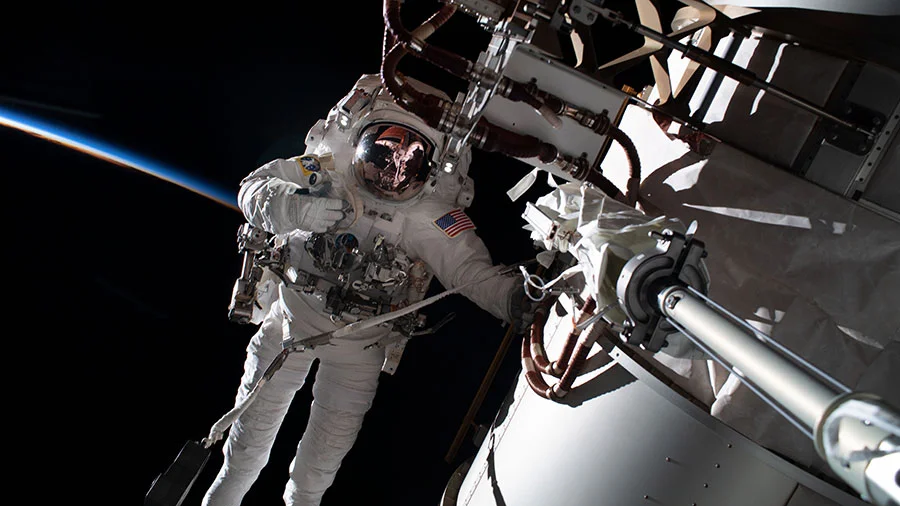Low gravity conditions in space cause heart damage
- September 24, 2024
- 0
The low gravity of space can cause serious damage to heart tissue, according to a new study. Heart tissue exposed to low gravity showed signs of mitochondrial damage
The low gravity of space can cause serious damage to heart tissue, according to a new study. Heart tissue exposed to low gravity showed signs of mitochondrial damage

The low gravity of space can cause serious damage to heart tissue, according to a new study. Heart tissue exposed to low gravity showed signs of mitochondrial damage and oxidative stress, the key symptoms of heart failure.
For the study, experts from Johns Hopkins University organized a 30-day stay at the International Space Station for 48 samples of bioengineered human heart tissue.
Heart tissue in low gravity conditions
After analysis, the experts found that the low gravity weakened the heart tissue and disrupted its normal beating rhythm, compared with control samples stored on Earth. According to the scientists, the heart tissue “doesn’t feel so bad in space.” Over time, the tissues on the space station fought with only half the strength of their Earth counterparts.
Consequences of long space flights
“Given current plans for manned missions to Mars and beyond, the need to better understand, prevent, and counteract the harmful effects of long-duration spaceflight on the body becomes increasingly important,” the authors of the study note.
Previous studies have shown that astronauts returning to Earth often experience age-related problems such as decreased heart muscle function and arrhythmias (irregular heartbeats), some of which disappear when they return.
However, project leader Professor Deok-Ho Kim (Deok-Ho Kim) explained that scientists are looking for ways to study these effects at the cellular and molecular level in order to develop strategies to ensure the safety of astronauts during long space flights.
Bioengineered tissues of the heart
The project used heart muscle cells (cardiomyocytes) derived from human induced pluripotent stem cells (iPSCs) developed by Jonathan Tsui, a former graduate student in Kim’s lab at the University of Washington. Cui later continued his space biology research with Professor Kim at Johns Hopkins University.
The bioengineered heart tissue was placed on a miniature tissue chip that mimics the environment of an adult human heart. The tissue chip was designed to line up cells between two posts, allowing researchers to collect data on how the tissues contract.
Sending heart tissue into space
To transport the heart tissue for SpaceX’s CRS-20 mission, which launched in March 2020, Cui personally transported the tissue chambers by hand to Florida, where he cared for them for a month at Kennedy Space Center.
On the space station, real-time data was collected for 10 seconds every 30 minutes, measuring the strength of tissue contractions, known as twitch force, and detecting irregular beating patterns.
Astronaut Jessica Meir helped maintain the experiment by replacing the liquid nutrients surrounding the tissues weekly and storing samples at regular intervals for further genetic and visual analysis.
Preservation of tissue vitality
On Earth, a second set of heart tissues, obtained in the same way, were placed in the same control rooms. Once the space tissue cameras returned to Earth, Cui continued to collect data from the tissues. “An incredible amount of advanced technology in stem cell and tissue engineering, biosensors, bioelectronics and microfabrication has been used to make these tissues viable in space,” said Professor Kim, whose team developed the tissue chip for this project and future research. .
Devin Mair, a former graduate student in Kim’s lab and now a postdoctoral researcher at Johns Hopkins University, analyzed the tissue’s ability to contract.
Weakened tissues and potential heart disease
In space, heart muscle tissue not only weakens, it also develops irregular beating patterns known as arrhythmias, which can potentially lead to heart failure.
Normally the time between one impact and the next is about a second, but in space-related tissues this time was increased by almost fivefold. However, when the tissues returned to Earth, their firing rate gradually returned to near-normal levels.
The researchers also found that sarcomeres, bundles of proteins that facilitate contraction in muscle cells, became shorter and more irregular in space-related tissues, a sign of heart disease. Mitochondria, which are responsible for energy production in cells, also became larger, rounder and lost their characteristic curves, suggesting that energy production was impaired.
Inflammation and oxidative damage
Finally, Meir, along with assistant professor Eun Hyun Ahn and graduate student Zhipeng Dong, analyzed gene activity in the tissues.
Heart tissue that spent time in space showed increased expression of genes associated with inflammation and oxidative damage, common markers of heart disease and consistently seen in post-flight astronaut health checks.
Protecting the heart from damage in space
Professor Kim’s team sent a second batch of 3D-designed heart tissue to the space station in 2023 to test drugs that could protect cells from the damaging effects of low gravity.
This research could lead to the development of treatments that could not only help astronauts keep their hearts functioning during spaceflight, but also benefit people on Earth as they age. The team is also continuing to develop the tissue-on-a-chip system by studying the effects of radiation on heart tissue at NASA’s Space Radiation Laboratory.
The space station orbits within Earth’s magnetic field, which shields its occupants from most cosmic radiation, but more research is needed to understand the effects of cosmic radiation on astronauts’ cardiovascular health during long missions outside this protective zone. The research was published in the journal Proceedings of the National Academy of Sciences.
Source: Port Altele
As an experienced journalist and author, Mary has been reporting on the latest news and trends for over 5 years. With a passion for uncovering the stories behind the headlines, Mary has earned a reputation as a trusted voice in the world of journalism. Her writing style is insightful, engaging and thought-provoking, as she takes a deep dive into the most pressing issues of our time.